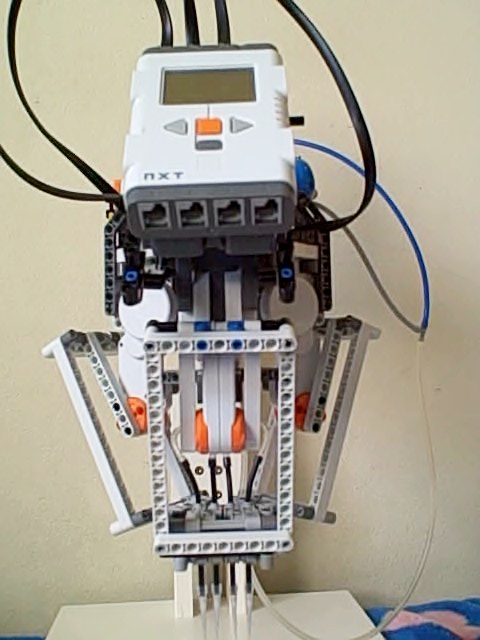Team:Washington-Software
From 2009.igem.org
| Line 4: | Line 4: | ||
<h4>'''BioBrick-A-Bot: Lego robot for Automated BioBrick DNA Assembly'''</h4> | <h4>'''BioBrick-A-Bot: Lego robot for Automated BioBrick DNA Assembly'''</h4> | ||
| - | [[Image:Robot Close Up.jpg| | + | [[Image:Robot Close Up.jpg|thumb|right|BioBrick-A-Bot]] |
Commercial Liquid Handling Systems are extremely expensive, and are typically beyond the reach of the average molecular biologist interested in performing high throughput methods. To address this problem, we design and implement a liquid handling system built from commonly accessible Legos. Our goal is the automation of BioBrick assembly on a platform that can itself be easily replicated and we demonstrate a proof-of-principle for this system by transferring colored dye solutions on a 96-well plate. We introduce a new concept called LegoRoboBrick. The liquid handling system is build from 3 new LegoRoboBrick modular components: ALPHA (Automated Lego Pipette Head Assembly), BETA (BioBrick Environmental Testing Apparatus), and PHI (Pneumatic Handling Interface). We will demonstrate that the same BioBrick assembly software can run on multiple plug-and-play LegoRoboBrick instances with different physical dimensions and geometric configurations. The modular design of LegoRoboBricks allows easy extension of new laboratory functionalities in the future. | Commercial Liquid Handling Systems are extremely expensive, and are typically beyond the reach of the average molecular biologist interested in performing high throughput methods. To address this problem, we design and implement a liquid handling system built from commonly accessible Legos. Our goal is the automation of BioBrick assembly on a platform that can itself be easily replicated and we demonstrate a proof-of-principle for this system by transferring colored dye solutions on a 96-well plate. We introduce a new concept called LegoRoboBrick. The liquid handling system is build from 3 new LegoRoboBrick modular components: ALPHA (Automated Lego Pipette Head Assembly), BETA (BioBrick Environmental Testing Apparatus), and PHI (Pneumatic Handling Interface). We will demonstrate that the same BioBrick assembly software can run on multiple plug-and-play LegoRoboBrick instances with different physical dimensions and geometric configurations. The modular design of LegoRoboBricks allows easy extension of new laboratory functionalities in the future. | ||
Revision as of 23:23, 20 October 2009

| Home | Team | Project | Modeling | Notebook | Challenges | Miscellaneous |
|---|
Abstract
BioBrick-A-Bot: Lego robot for Automated BioBrick DNA Assembly
Commercial Liquid Handling Systems are extremely expensive, and are typically beyond the reach of the average molecular biologist interested in performing high throughput methods. To address this problem, we design and implement a liquid handling system built from commonly accessible Legos. Our goal is the automation of BioBrick assembly on a platform that can itself be easily replicated and we demonstrate a proof-of-principle for this system by transferring colored dye solutions on a 96-well plate. We introduce a new concept called LegoRoboBrick. The liquid handling system is build from 3 new LegoRoboBrick modular components: ALPHA (Automated Lego Pipette Head Assembly), BETA (BioBrick Environmental Testing Apparatus), and PHI (Pneumatic Handling Interface). We will demonstrate that the same BioBrick assembly software can run on multiple plug-and-play LegoRoboBrick instances with different physical dimensions and geometric configurations. The modular design of LegoRoboBricks allows easy extension of new laboratory functionalities in the future.
Project Goals
- Low Cost – Robot cost significantly lower than $10,000. (Actual cost:~$600)
- Hardware Platform that is easily accessible
- Hardware Design that is easily replicable by other iGEM teams.
- Software Design that is robust, plug and play. Can swap modules from other iGEM teams.
- Design that is easily extensible, to allow future collaboration with other iGEM teams.
 "
"
